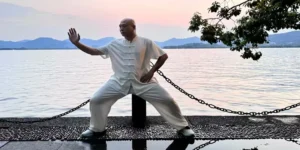As we age, many seniors face common challenges like reduced mobility, joint stiffness, increased fall risk, and chronic pain. While the ancient Chinese practice of Tai Chi offers a powerful solution.
This gentle, flowing tai chi for seniors is recognized by medical professionals for its benefits specifically tailored to older adults. Regular Tai Chi for seniors enhances balance and coordination, significantly reducing the risk of falls.
It gently lubricates joints, easing arthritis pain and improving flexibility. The mindful, meditative aspect lowers stress hormones and promotes deep relaxation, combating anxiety and improving sleep. Furthermore, studies show Tai Chi can help manage symptoms of chronic conditions like hypertension, heart disease, and even mild cognitive decline.
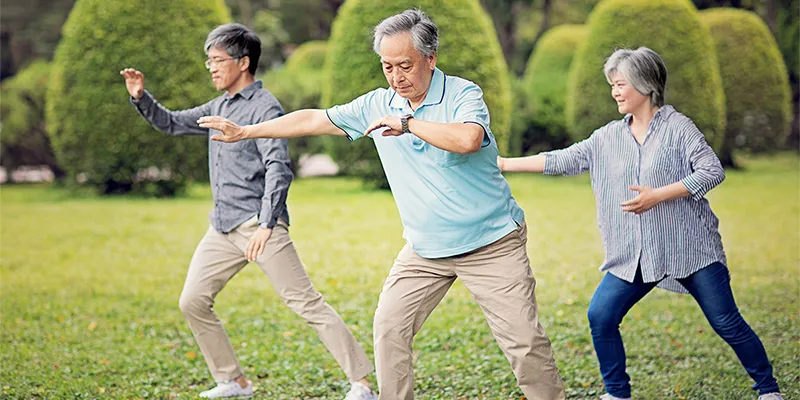
This article will guide seniors through finding the best Tai Chi styles suited to their individual needs and physical condition, ensuring a safe, enjoyable, and true practice.
What is the Best Tai Chi for Seniors?
Not all Tai Chi styles are equal, especially when considering the unique needs and limitations of older practitioners. The “best” tai chi for seniors style depends on the person. Here are the most suitable styles:
Yang Style Tai Chi: The Gold Standard for Most Seniors
Benefits: It is large, slow, graceful, and continuous movements performed in an upright posture. Yang tai chi forms focus on smooth transitions and weight shifting and are best for building leg strength, improving dynamic balance, and enhancing overall coordination, directly targeting fall prevention. Its gentle motion minimizes joint stress while promoting relaxation and mental focus.
Best For most seniors, especially beginners, those with mild to moderate balance issues, arthritis sufferers, and individuals seeking stress reduction.
Please contact us for details.
Wu Style Tai Chi: Stability and Compact Movements
Benefits: Slightly forward posture, smaller movements, and a focus on precise weight distribution and internal awareness. The compact form reduces the range of motion compared to Yang Tai Chi, making it easier for those with hip or knee limitations. Its subtle weight shifts are excellent for body stability.
Best For seniors with joint concerns, especially hips/knees, who find larger movements challenging; those recovering from certain injuries; and individuals seeking a strong focus on internal energy cultivation and balance. Its inherent stability benefit is excellent for Fall Prevention.
Sun Style Tai Chi: Gentle Steps and Upright Posture
Benefits: Its smooth, flowing steps that follow the hands, like a flowing river; higher stances; and a consistently upright posture. This eliminates deep knee bends and reduces spinal twisting, placing minimal stress on joints. The flexible steps significantly improve coordination and dynamic balance.
Best for seniors with significant arthritis (particularly in knees, hips, or spine), osteoporosis concerns, or those who find deep stances uncomfortable. Its smooth, dance-like step is also very appealing and easy to learn.
Chen Style Tai Chi: Suitable For Healthier Seniors
Benefits: Chen style tai chi is the oldest style, featuring a mix of slow, flowing movements and occasional faster, more explosive bursts and lower stances. Traditional Chen is generally not recommended for most seniors due to these demanding aspects. However, modified Chen styles focus primarily on the slow, spiral movements, which are excellent for joint mobility, core strength, and fascial health, while eliminating the explosive jumps and deep stances.
Best for healthy, active older adults without major joint problems who are interested in the unique spiraling energy and martial arts roots of Chen style Tai Chi, but must be taught under the guidance of an experienced modified Chen Tai Chi instructor. Not for beginners with significant physical limitations.
Simplified 24 Posture Tai Chi: Ideal for Starting
Best For absolute beginners of all fitness levels and seniors, those in group class settings where consistency is important, and individuals rehabilitating or rebuilding fitness. It’s the most commonly taught style form worldwide and highly recommended as a starting point.
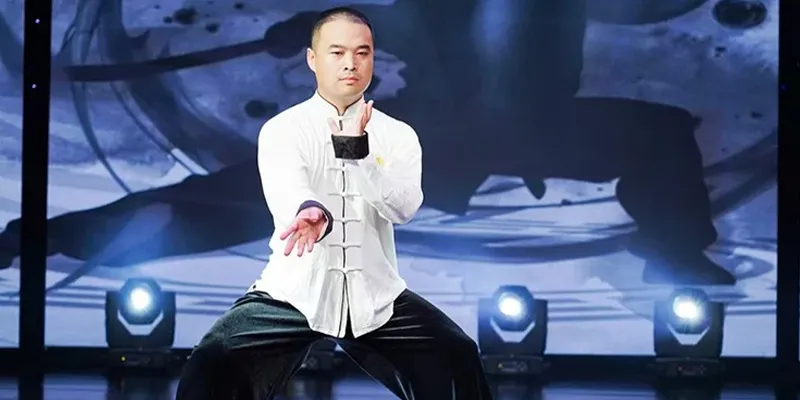
Benefits: Rooted in the 1950s in China, this form distills the core principles and most beneficial movements of traditional Yang style into a shorter, more accessible sequence, typically 5-8 minutes. It retains the slow, flowing, upright nature, making it perfect for learning basics, improving balance, building strength, and experiencing relaxation without the complexity of longer forms.
Shen Jiangfei is an authentic Tai Chi successor, contact me for more information.
For most seniors starting Tai Chi, Yang Style Simplified 24-Posture or Sun Style offer the safest, easiest, and broadly beneficial entry points. The Wu style is an excellent alternative, particularly for stability and those with joint concerns. Selecting classes in these styles first before considering modified Chen.
Tai Chi for Seniors Benefits
Tai Chi for seniors benefits extend far beyond simple exercise:
Fall Prevention and Enhanced Balance: Tai Chi for seniors continuously challenges and improves static and dynamic balance through controlled weight shifts, coordinated movements, and strengthening the muscles of the legs and core. Studies consistently show significant reductions (often 20-45%) in fall rates among regular practitioners.
Arthritis Pain Relief and Joint Health: The slow, controlled movements take joints through their natural range of motion without jarring impact. This promotes synovial fluid joint lubrication, improves flexibility, strengthens surrounding muscles for better support, and reduces inflammation and stiffness, leading to decreased pain and improved function.
Stress Reduction and Mental Well-being: Deep, diaphragmatic breathing combined with focused, mindful movement creates a powerful meditation in motion. This lowers cortisol levels, reduces anxiety, improves mood, enhances sleep quality, and fosters a profound sense of calm and inner peace. The social aspect of group classes also combats isolation.
Improved Strength and Flexibility: While gentle, Tai Chi for seniors is weight-bearing and engages major muscle groups, particularly in the legs and core. Holding postures and moving slowly builds isometric strength, while the flowing sequences gradually increase flexibility and motion ranges.
Cardiovascular and Respiratory Health: The continuous movement and deep breathing provide mild aerobic conditioning, improving circulation and lung capacity. This helps heart health and overall stamina.
Chronic Disease Management: Research indicates Tai Chi for seniors can help manage symptoms and improve quality of life for those with conditions like hypertension, type II diabetes, COPD, and heart failure, and it can even improve focus and brain blood flow.
Body Awareness and Proprioception: Tai Chi for seniors heightens the connection between mind and body, improving awareness of posture, alignment, and movement in space. It is crucial for safe movement in daily life.
Essential Considerations for Senior Practitioners
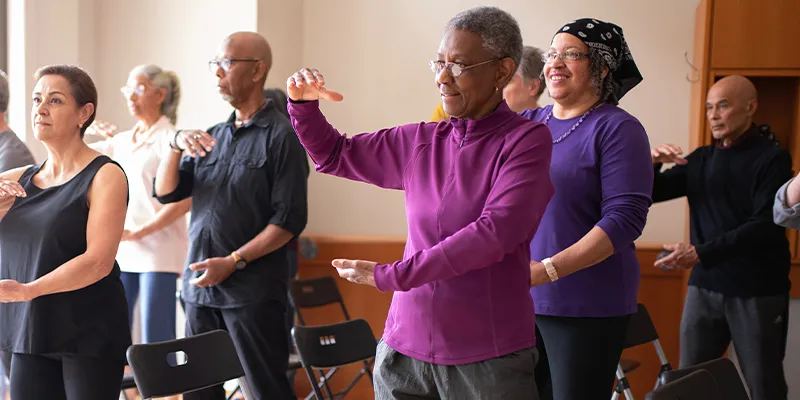
Practice with awareness, not force.
- Every Tai Chi movement is driven by awareness. Elderly practitioners should choose a quiet environment to maintain a positive mental state and not talk while practicing, as this can lower the effectiveness of the exercise.
- Also, choose appropriate postures based on individual physical conditions and health, practicing according to your abilities.
- For example, the elderly and frail can practice higher postures. Those with hypertension or heart disease should avoid forcing their legs to lift or squat when performing movements like “split legs,” “kick legs,” and “downward stance.” Simply following your awareness will achieve excellent results.
Do Tai Chi stretches before practice.
- Generally speaking, it’s best to practice Tai Chi for seniors early in the morning. It’s best to empty your bowels and bladder, drink some milk or malted milk, eat a few crackers, but don’t overeat. Do some Tai Chi stretching exercises, then stand still for a moment, regulate your breathing, clear your mind, and prepare for practice.
Maintain gentleness during practice.
- Due to physical limitations, elderly people should practice Tai Chi gently, relaxed, naturally, and slowly, avoiding rapid breathing and increased heart rate. This is important even for beginners and is especially important for those who are physically weak or have chronic illnesses.
Maintain even and deep breathing.
- Even and deep breathing not only improves the effectiveness of inhalation and exhalation but also enhances blood circulation and internal organ function.
- Because this is an abdominal exercise combined with movement, beginners may find it difficult. However, you should gradually adapt as you practice. Don’t rush. Never force your breathing to achieve “Qi sinking into Dantian,” as this can cause dizziness, shortness of breath, and other symptoms that interfere with natural breathing.
Pay attention to your body’s reactions.
- Distinguish between muscle fatigue and sharp joint pain. Stop immediately if you feel dizziness, chest pain, or severe discomfort. Use higher stances if knees are sensitive, reduce the range of motion if needed, and use a chair for support during standing practice or for seated Tai Chi. Don’t compare yourself to others.
Quality over quantity.
- Prioritize an upright spine, relaxed shoulders, slightly tucked knees tracking over toes, and avoiding locking joints over achieving deep stances or perfect form. Tai Chi for seniors is a journey, not a race. Master the basics of weight shifting, posture, and relaxation before focusing on complex sequences.
Tai Chi for Seniors Before Practicing
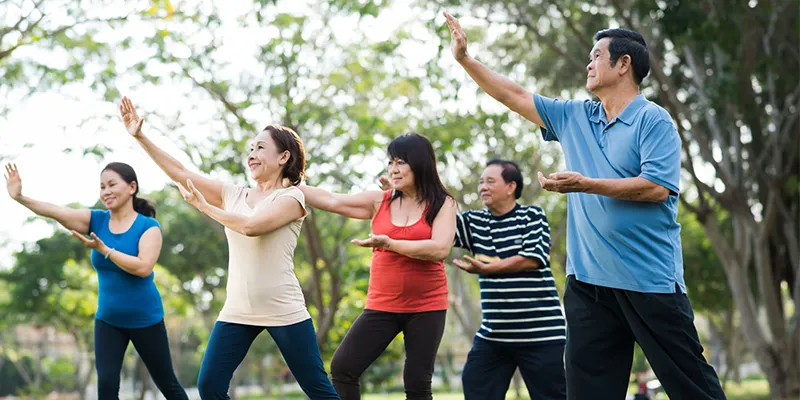
Proper preparation enhances tai chi for seniors safety:
Clothing: Wear loose, comfortable, breathable clothing that allows unrestricted movement, like cotton pants, T-shirts, and sweats. Avoid tight belts or restrictive jeans. Flat, flexible-soled shoes like Tai Chi/kung fu shoes or thin-soled sneakers or non-slip socks are essential for stability and proper foot articulation. Avoid thick, cushioned running shoes.
Training Space: Choose a quiet, well-lit area with a flat, stable, non-slip surface. Ample space around you to move arms and legs freely without hitting furniture or walls. Outdoors is lovely, but ensure the ground is level and dry.
Movement Standards: Focus on correct principles, not perfection. Key standards include: Upright Posture: Head suspended as if by a string, spine straight but not rigid, shoulders relaxed and down, tailbone gently tucked.
Weight Shifting: Move deliberately, transferring weight fully from one leg to the other with control.
Knee Alignment: Knees should always track in the same direction as the toes, never collapsing inward or bowing outward excessively. Avoid letting the knee extend beyond the toes in lunges.
Relaxation Song: Release unnecessary tension in the shoulders, jaw, chest, and hands while maintaining structural alignment. Breathe naturally and deeply.
Speed: Seniors should prioritize slow, deliberate movement. This allows for better control and deeper focus on alignment and sensation and minimizes the risk of strain or imbalance.
Posture: Maintaining the upright, aligned posture described above is non-negotiable for safety and effectiveness. Avoid leaning forward excessively or overarching the lower back.
Keep your speed steady: When practicing Tai Chi for seniors, it’s better to practice slowly rather than quickly. Start by practicing slowly to build your foundation and master the movements. Once you’ve mastered them, maintain a steady pace from beginning to end. A set of “Simplified Tai Chi” is performed at a normal speed of 4 to 6 minutes. Some people practice at a slower pace, but it shouldn’t be too slow. A set of “48-Posture Tai Chi” takes 8 to 10 minutes, and “88-Posture Tai Chi” takes about 20 minutes.
Common Pains in Tai Chi for Seniors
While Tai Chi for seniors is low-impact, improper practice can cause discomfort, commonly in:
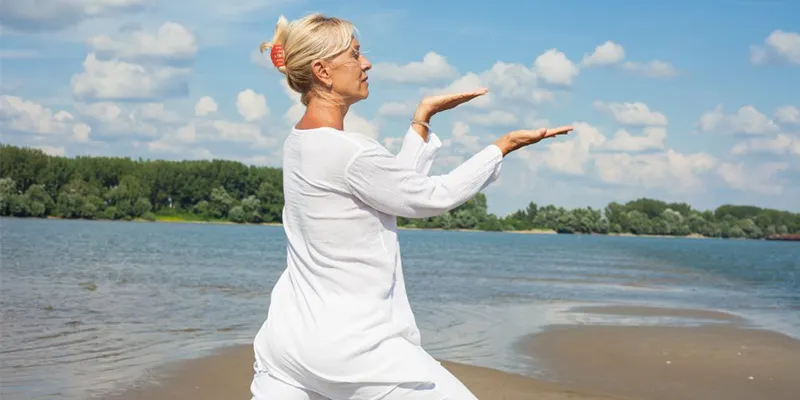
Knee Pain: The most frequent pain in tai chi for seniors.
Causes: Knees extending beyond toes in lunges/stances, knees collapsing inward or bowing outward, locking the knees, twisting the knees while bearing weight, practicing with pre-existing significant arthritis without modifications.
Solution: Proper alignment is knee over ankle, tracking with toes; use higher stances, reduce the depth of movements, strengthen quadriceps and glutes, avoid twisting under load, consult a physiotherapist for specific exercises, and use chair support if needed.
Lower Back Pain:
Causes: Arching the back, rounding the back excessively, failing to engage the core muscles, twisting forcefully without proper alignment, pre-existing back conditions.
Solution: Maintain the “neutral spine” with a gentle pelvic tuck, engage the lower abdominal muscles lightly to support the spine, focus on turning from the waist/dan tian rather than just the shoulders, avoid deep forward bends if prone to back issues, and strengthen core muscles.
Neck Pain:
Causes: Craning the neck forward to look at feet or hands, tensing the shoulders, which pulls on the neck, holding the head tilted or turned for prolonged periods, and poor overall posture.
Solution: Keep the chin slightly tucked, imagine the head floating upwards, relax the shoulders down, maintain the head in a neutral position aligned with the spine, and avoid straining to look down—use peripheral vision or slight eye movement instead of full neck flexion.
If pain persists despite adjustments and rest, consult your doctor.
Tai Chi vs. Qigong

While often practiced together, Tai Chi and Qigong are distinct practices that seniors may encounter:
Tai Chi Quan: A complete internal martial art. While practiced for health today, its movements are derived from martial applications.
- Form: Primarily practiced through choreographed sequences of movements that flow continuously from one posture to the next.
- Features: Integrates movement, breath, and mental focus into a dynamic whole. Emphasizes principles like relaxation, alignment, weight shifting, balance, and the cultivation of internal energy through movement. The continuous flow is characteristic.
- Complexity: Generally has a steeper learning curve due to memorizing sequences and coordinating complex whole-body movements with breath and intent.
Qigong: A system of energy cultivation practices. “Qi” means vital energy, and “Gong” means skill or work.
- Form: Consists of individual exercises, postures, breathing techniques, and meditations. These can be static or involve simple, repetitive movements, often performed independently of each other.
- Features: Primarily on cultivating, balancing, and circulating Qi for health, healing, and vitality. Breathing is often more explicitly controlled than in Tai Chi. While mindful, the movements are usually simpler and serve the breath and energy focus.
- Complexity: Easier to learn initially, as many practices involve single, repeatable movements or static postures.
Tai Chi for seniors incorporates Qigong principles, and many classes begin with Qigong warm-ups. Qigong can be an excellent practice for seniors, especially those with very limited mobility, or as a complementary practice to Tai Chi.
Conclusion
While the question “What is the best Tai Chi for seniors?” has no single answer; the gentle, flowing movements of Yang, Wu, and Sun styles, especially the simplified 24 posture form, provide the safest and most effective gateway for the majority. Remember, the true “best” style is the one you can practice consistently, safely, and enjoyably under the guidance of a qualified instructor who understands the needs of older adults.

